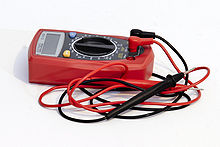Ohm

The ohm (symbol: Ω) is the SI derived unit of electrical resistance, named after German physicist Georg Simon Ohm.
Definition

The ohm is defined as a resistance between two points of a conductor when a constant potential difference of 1 volt, applied to these points, produces in the conductor a current of 1 ampere, the conductor not being the seat of any electromotive force.[1]
where:
In many cases the resistance of a conductor in ohms is approximately constant within a certain range of voltages, temperatures, and other parameters; one speaks of linear resistors. In other cases resistance varies (e.g., thermistors).
Commonly used multiples and submultiples in electrical and electronic usage are the milliohm, ohm, kilohm, megohm, and gigaohm.[2]
In alternating current circuits, electrical impedance is also measured in ohms.
Conversions
The siemens (symbol: S) is the SI derived unit of electric conductance and admittance, also known as the mho (ohm spelled backwards, symbol is ℧); it is the reciprocal of resistance in ohms.
Power as a function of resistance
The power dissipated by a linear resistor may be calculated from its resistance, and voltage or current. The formula is a combination of Ohm's law and Joule's laws:
where P is the power in watts, R the resistance in ohms, V the voltage across the resistor, and I the current through it.
This formula is applicable to devices whose resistance varies with current.
Ohm symbol
When preparing electronic documents, some document editing software will attempt to use the Symbol typeface to render the Ω character. Where the font is not supported, a W is displayed instead ("10 W" instead of "10 Ω", for instance). As W represents the watt, the SI unit of power, not resistance, this can lead to confusion.
An "R" can be used instead of the Ω symbol if it is not supported, thus, a 10 Ω resistor can also be represented as 10R. This is the British standard BS 1852 code. It is used in many instances where the value has a decimal place i.e. 5.6 Ω would be listed as 5R6. One advantage of this method is that it is relatively easy to "rub off" a decimal point symbol ".", changing the apparent value, compared to the "R" symbol, which would require more effort.
Unicode encodes the symbol as U+2126 Ω OHM SIGN, distinct from Greek omega among letterlike symbols, but it is only included for backwards compatibility and the Greek uppercase omega character U+03A9 Ω GREEK CAPITAL LETTER OMEGA (Ω, Ω) is preferred.[3] In DOS and Windows, the alt code ALT 234 may produce the Ω symbol.
See also
References
- ^ BIPM SI Brochure: Appendix 1, p. 144
- ^ The NIST Guide to the SI: 9.3 Spelling unit names with prefixes reports that IEEE/ASTM SI 10-2002 IEEE/ASTM Standard for Use of the International System of Units (SI): The Modern Metric System states that there are three cases in which the final vowel of an SI prefix is commonly omitted: megohm, kilohm, and hectare. "In all other cases in which the unit name begins with a vowel, both the final vowel of the prefix and the vowel of the unit name are retained and both are pronounced."
- ^ Excerpts from The Unicode Standard, Version 4.0, accessed 11 October 2006


